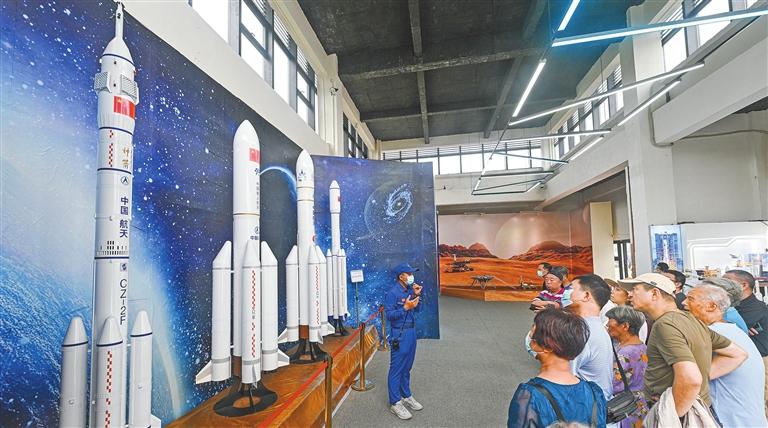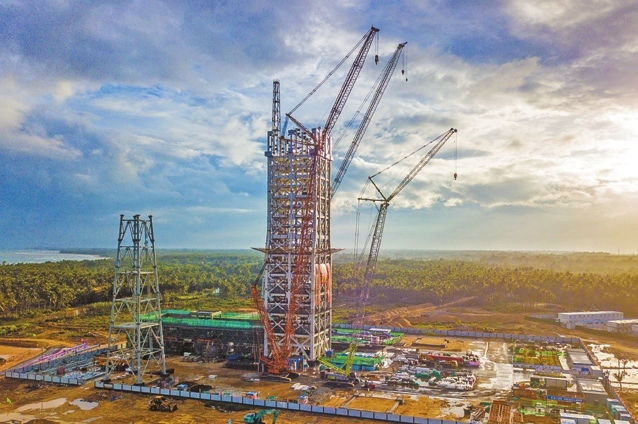

HAINAN, a tropical island resort, draws tourists with its sandy beaches, fresh coconuts, and duty-free shopping. Recently, the coastal province added another awe-inspiring activity: watching space launches. The latest event was the May 10 liftoff of the Tianzhou-6 cargo craft from the seaside Wenchang Spacecraft Launch Center, which is only a two-hour drive from the Haikou Meilan International Airport. Tens of thousands of visitors poured into Wenchang, where the launch site is located, as the rumble of the carrier rocket and the roar of the crowd swept over the beach. Two days ahead of the space mission, rooms at major local hotels were already sold out at prices several times higher than usual. Buses became packed, streets were congested, and car queues were seen everywhere in Longlou, a “space town” in Wenchang. “In the past, we were very secretive about the launch plans, which were revealed to the public just after the rockets blasted off into the sky,” said Sun Jiadong, an aerospace engineer and the head of the overall design team of China’s first satellite Dongfanghong-1. From a guarded secret to a live launch viewed by thousands, the change reflects China’s growing confidence in space technology. Wenchang launch site, China’s youngest and only coastal launch facility, was first used in 2016. Since then, it has witnessed several launches of the country’s important spacecraft, such as heavy-lift carrier rockets, space station modules, and lunar probes. According to the local statistics bureau, from 2016 to 2022, the number of overnight tourist arrivals increased from 1.99 million to 3.62 million, and total tourism revenue rose from 1.4 billion yuan to 5.2 billion yuan (US$199-738 million). Elsewhere, the Jiuquan Satellite Launch Center in Northwest China’s Gobi Desert is a popular tourism destination and the country’s only site for manned spacecraft liftoff. Listed as one of the world’s top space travel destinations by Lonely Planet, Jiuquan has aerospace museums, launch towers and simulated taikonaut apartment compounds to offer. It’s easy to spot space enthusiasts near the site carrying tents and telescopes, waiting for the moment when rockets thunder skyward. Businesspeople across China also see money-making opportunities with the country’s space progress. In Qinghai Province, the town of Lenghu is known as “Mars Camp” due to its eerily eroded desert landscape resembling the remote red planet’s surface. One tour project offers a fully immersive experience of life on Mars, where participants hike in the desert, search for water resources, and pretend to be taikonauts facing life-threatening challenges. Mars-related science courses are also provided to young visitors. “Bookings stretch into October,” said Yuan Zhenmin, executive deputy general manager of Lenghu Mars Town Culture and Tourism Development Co., which operates the project. Similar Mars simulation bases have opened across the northwestern region after the launch of Mars probe Tianwen-1. Some have space-themed hotels and restaurants, while others have sleeping capsules accommodating up to nearly 200 visitors. Photos of visitors donning a spacesuit in Mars Base 1, a simulated Martian habitat in Gansu Province, have garnered extensive media coverage. Xichang, a town in Southwest China’s Sichuan Province, has also prospered from space-themed tourism. Two kilometers away from the Xichang Satellite Launch Center, a small village of ethnic Yi people thrives on family inns. It used to be a poor village with no paved roads, with locals reliant on farm work for income. Thanks to frequent satellite launches, Xichang has gained popularity among space enthusiasts. Villagers now operate restaurants and guesthouses for launch center visitors and plant value-added agricultural products, such as tea and walnuts, to boost earnings. Wei Xiang, a researcher at the Chinese Academy of Social Sciences, cited Xichang as a prime example of how space-themed tourism has bolstered local leisure industries and tourism agriculture, increasing production, creating jobs, and generating greater economic benefits. National Tourism Day, marked every May 19 in China, shone a spotlight on space-themed tourism. Wei believes that more industries, such as culture and education, will collaborate with this emerging sector, providing added impetus for tourism growth.(Xinhua) | 
